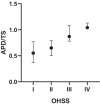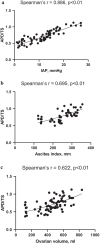Are anthropometric data a tool for determining the severity of OHSS? Yes, it could be!
- PMID: 35538521
- PMCID: PMC9092801
- DOI: 10.1186/s12905-022-01701-5
Are anthropometric data a tool for determining the severity of OHSS? Yes, it could be!
Abstract
Background: All management guidelines of ovarian hyperstimulation syndrome (OHSS) recommend daily monitoring of women's body weight, waist circumference and note that as indicators increase, the severity OHSS also increases. However, the dynamics of abdominal size and its relationship with markers of OHSS severity have not been highlighted. The purpose of this study is to assess the usefulness of various anthropometric indicators for determining the degree of OHSS severity as well as paracentesis indications.
Methods: Observational study including 76 women complaining with OHSS. Clinical history, physical examination, laboratory tests, and ultrasound measurement of the ovarian volume (OV) and ascites index (AsI) were done in all cases. Intra-abdominal pressure (IAP) was assessed using an intravesical manometer. The anteroposterior diameter of the abdomen (APD) and transverse diameter of the abdomen (TS) were measured with a pelvimeter. The APD/TS ratio was calculated.
Results: The APD/TS ratio increased progressively and tended to be the highest in the most symptomatic stage of OHSS (Kruskal-Wallis test, p < 0.001). The median APD/TS was significantly lower in patients with mild OHSS (0.55 [IQR, 0.44-0.64]) compared with severe OHSS (0.87 [IQR, 0.80-0.93]; p < 0.001) or critical OHSS (1.04 [IQR, 1.04-1.13]; p < 0.001). Similarly, the median APD/TS of the moderate OHSS group (0.65 [IQR, 0.61-0.70]) was significantly lower than that of the severe (p < 0.001) and critical OHSS group (p = 0.001). There was a strong positive correlation between APD/TS and IAP (Spearman's r = 0.886, p < 0.01). The APD/TS ratio showed a significant positive correlation with AsI (Spearman's r = 0.695, p < 0.01) and OV (Spearman's r = 0.622, p < 0.01). No significant differences were observed in age, height, weight, body mass index, hip circumference or waist circumference between moderate, severe and critical OHSS groups.
Conclusions: The APD/TS ratio is related to the severity of OHSS. Monitoring APD/TS dynamics could be a method of indirectly controlling intra-abdominal volume, compliance of the abdominal wall and IAP. In conjunction with clinical and laboratory data, APD/TS might be an indicator for paracentesis.
Keywords: Anthropometic indicators; Ascites index; Compliance of the abdominal wall; Intra-abdominal hypertension; Intra-abdominal pressure; Ovarian hyperstimulation syndrome.
© 2022. The Author(s).
Conflict of interest statement
On behalf of all authors, the corresponding author states that there is no conflict of interest.
Figures
References
-
- The Management of Ovarian Hyperstimulation Syndrome. Royal College of Obstetricians and Gynaecologists-Green-top Guideline. https://www.rcog.org.uk/globalassets/documents/guidelines/greentopguidel.... 2016. Accessed 26 April 2021.
Publication types
MeSH terms
Substances
Associated data
LinkOut - more resources
Full Text Sources
Research Materials



